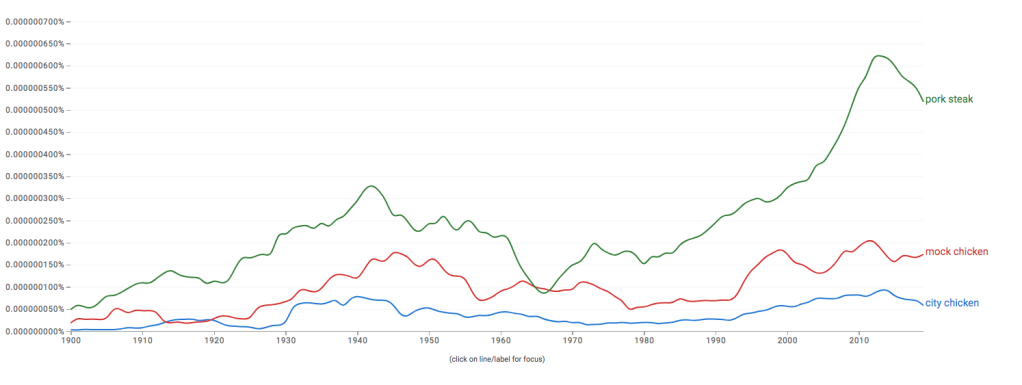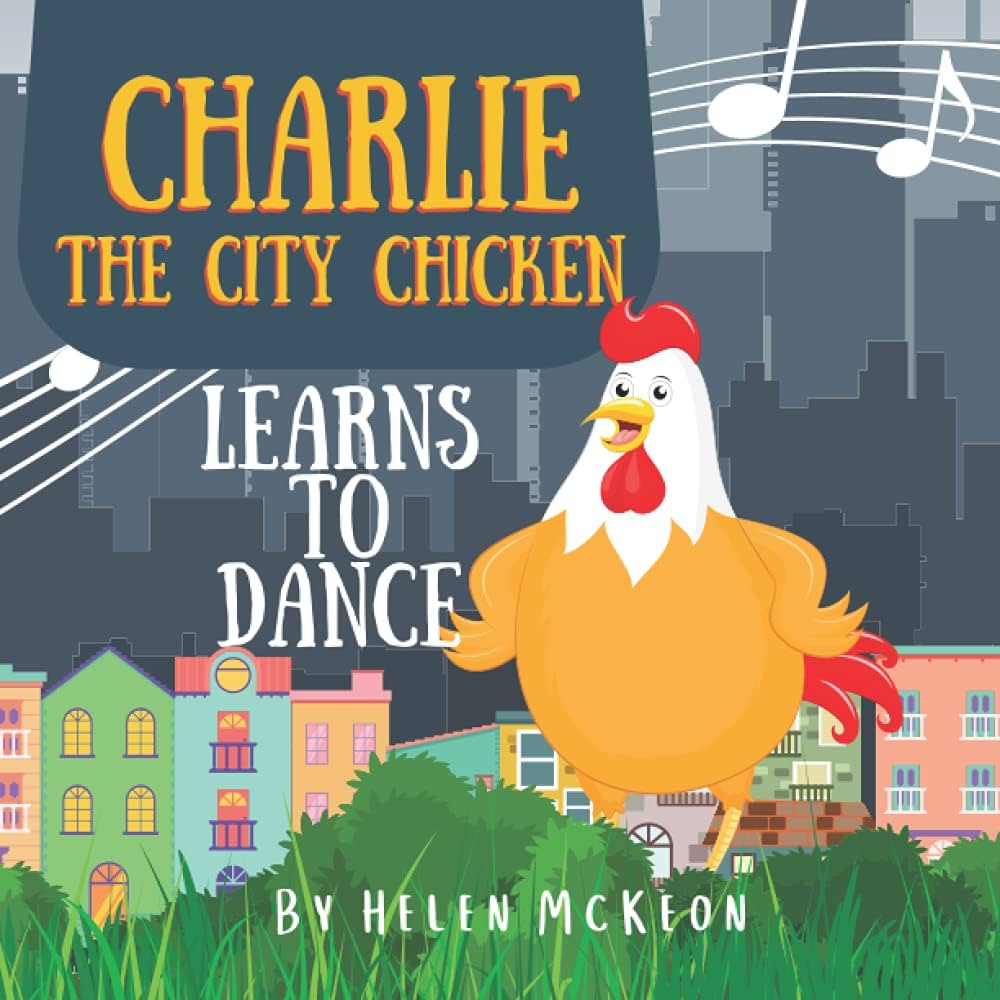
For some reason last week I just suddenly thought of “city chicken” for the first time in four or five decades. And turns out I apparently did not dream it — as a matter of fact, city chicken even has its own Wikipedia page, which defines it thusly: “An American entrée consisting of cubes of meat, typically pork, which have been placed on a wooden skewer (approximately 4–5 inches long), then fried and/or baked. Depending on the recipe, they may be breaded. Despite the name of the dish, city chicken almost never contains chicken.”
The page goes on to trace the dish back to the Great Depression in Pittsburgh, even a couple decades earlier if a similar recipe known as mock chicken counts. (Amazingly, searching the New York Times archives for references to city chicken — as opposed to chickens who just happen to live in the city — yields nothing even well into the 1980s, whereas “mock chicken” shows up as early as 1917, though it is apparently vegan!: “a concoction that included several recognizable viands, among which were bread, sage, molasses and raisins. Some one said it tasted like turkey,.” Which, sorry, sounds disgusting. If I had access to Midwestern newspaper archives, I’d search those instead.)
“During the Depression, cooks used pork or in many cases veal because it was then cheaper than chicken in many cities, especially in meat packing centers such as Detroit, Cincinnati, Cleveland, Louisville, and Pittsburgh where such cuts were more readily available,” Wikipedia writes. Which explains why “the dish is popular in cities throughout the central and eastern Great Lakes region of Ohio and Michigan as well as the northeastern Appalachian regions of Pennsylvania and Upstate New York, and at least as far south and west as Louisville.”
“The dish is still popular in the Binghamton, NY area,” Wikipedia specifically emphasizes, “where at the turn of last century along with the growth of factories (especially EJ, cigar companies, Kilmer, etc.) the town was supplied with workers from immigrant communities abroad as well as from the coal mines of PA, stone quarries of northern NY, etc. Many or most of these were from more rural areas where farming for personal use to supplement their jobs was common (i.e. small vegetable gardens, hogs and chickens). In the tenement and row houses in Binghamton of that era it was rare to have enough land to raise chickens however slaughter houses (pork, lamb, veal, and beef) could still be located ‘in town’. The idea of breading veal or pork like fried chicken became a cheaper and popular meal.”
I must have known it myself from childhood years spent outside either Detroit or Cincinnati. (I’ve never lived in Binghamton, though I think I may have stayed in a hotel there once as a grown-up. ) What I was having trouble wrapping my head around before reading the above package, and okay maybe to some extent still have trouble believing, is why chicken would’ve been so much harder to get, therefore so much more expensive, than veal or pork during the Great Depression. I’m not a farmer, so I might be way off here, but aren’t chickens easier (and cheaper) to raise?? My formerly vegan daughter in Cleveland even keeps them in her yard! Though I do get how leftover scraps in general (of any meat) might be more affordable I guess. (For some reason the processing/meat-cubing is making me think of both gyros and Arby’s, both probably major stretches — in cook books, city chicken often looks more like meat loaf, or large oblong meatballs, on a stick.)
Renee Spencer Saller suggests to me that she thinks chickens “used to be considered something of a luxury, hence the expression ‘a chicken in every pot.’ (Then again, a cow wouldn’t fit in a pot.)” She also said hearing about city chicken reminds her that her own hometown “Saint Louis has this regional delicacy called pork steaks. People barbecue them. As a little kid I thought steaks and pork steaks were the same thing because my parents and grandparents and other relatives all grilled pork steaks and never beef steaks.” Cathy Pick, another St. Louisian, alerted me to the availability of antique molds on ebay that can be used to form other cuts of meat into the shape of a poultry drumstick. (New York Times, August 3, 1963: “For a meat company, two inventors have developed a mock chicken leg machine. According to patent 3,099,037, it will attach two-ounce servings of meat to sticks at the rate of one a second.”)

Since was curious what percentage of people I know were familiar with city chicken, naturally I posted a query to my facebook wall. Three people I graduated high school with in suburban Detroit knew it well — two because their grandmas made it; Tami Fisher because she used to serve this in a restaurant in the early 2000s. The same day I asked the question, she says someone coincidentally linked to a recipe on a facebook page she subscribes to.
Gail Vasku seemed sure that “it’s definitely a Polish dish. I’m not too far from Polish Market in Troy and on occasion I’ll get one from their hot food section. But it’s not as good as Grandma’s.” Likewise, Frank Eory’s “grandmother made city chicken all the time! I haven’t had it in over 40 years. I heard a mention of it a couple months ago and have been thinking about making it ever since.” (Whether its ethnicity is Polish may or may not be in dispute, given that Wikipedia claims “in Canada, it is quite popular in the ethnic Ukrainian regions of the west.”)
Affirming Midwestern answers, it should be noted, were not by any means limited to my fellow West Bloomfield High School alumni. Mike McGonigal says there’s still “plenty of it near here, Hamtramck way!” Outside of Michigan, Deb Sprague recalls it being “a weekly staple in Cleveland,” and Joseph McCombs adds that “it was very popular where I grew up outside Pittsburgh” as well.
Christina Ward, who lives “in Milwaukee, where a version was a popular school lunch item served at least once a month,” told me that “City Chicken/Mock Chicken legs are such an obsession of mine that I included them in the upcoming, toss off, work-for-hire cookbook I recently did…the Happy Days Cookbook. Was happy to find a place/excuse to include a recipe!”

“The down and dirty food history of Mock Chicken legs is very Midwestern in origin,” Ward reiterates. “It’s a post-World War I-era invention; when food shortages and meat-packer conglomerates fueled recipe innovation. That era was a time when veal was cheaper than chicken. The ‘mock chicken’ name was considered more working class vs. the middle class ‘City Chicken’ sobriquet.”
When I asked her whether Milwaukee kids today would still recognize it — since after all, she had said “a version was a popular school lunch item,” past tense — she answered that though “mock chicken legs were retired from the MPS [= Milwaukee Public Schools] menu in 2022,” “our local co-op meat department makes them about every two months as a ‘special’ item and they always sell out. Many smaller Midwest grocery stores and butchers still sell them, so if kids have Gen X/elder Millennial parents who eat meat…then yes, they’ll recognize it!”
In addition, James Auburn Toole, despite having “never heard of this particular delicacy,” mentioned that “when one of my friends from Mississippi came up to visit me in Boston, she called the pigeons we’d see on the street ‘city chickens’.” Steve Crawford, who lives in Fort Worth, says that he too is “not too familiar with ‘city chicken,’ but it’s my understanding that they dress snazzier and use more modern slang than their country bumpkin kinfolk.” And New Yorker Harley Judd Spencer, too, has “never heard of this. Buffalo wings started cause it was the cheapest cut. Now it’s the priciest. Sorry folx.”
